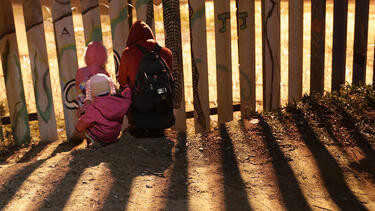Three Questions: Prof. Cristina Rodríguez on the Immigration Crises
Is there a crisis at the U.S. southern border? From the first moments of his presidential campaign, Donald Trump has warned of immigrants streaming into the United States. His critics describe a crisis of another kind, in which asylum seekers, including children, are delayed and imprisoned at the border. We asked Cristina Rodríguez of Yale Law School, whose research interests include immigration law and policy, to shed light on the reality behind the divisive politics.

Immigrants at a U.S.-Mexico border fence in Tijuana, Mexico, in December 2018. Photo by John Moore/Getty Images.
Where is the immigration system getting overwhelmed (or breaking down)?
Employers in most industries that rely on immigrant workers probably would argue that the system does not work as well as it should, as would many U.S. citizens or residents in the process of sponsoring a family member’s entry to the country. But the two most urgent and politically significant instances of systemic stress involve immigration from Latin America. Since the summer of 2014, unusually high numbers of migrants from Central America have been arriving at ports of entry, or crossing unlawfully in the spaces in between, to turn themselves in to border officials. They primarily seek asylum from extreme violence and other forms of deprivation, and they are increasingly women, children, and families, rather than young men traveling alone. The current administration has escalated its predecessor’s enforcement-oriented approach to the problem, but neither our existing bureaucracies at the border nor the political class have shown the capacity to manage this influx humanely.
This current pressure at the border highlights the second important source of stress. Illegal, labor-driven immigration from Mexico—a central feature of our system for decades—no longer presents a major concern. And yet, nearly 11 million immigrants without legal status remain in the United States, having become residents intertwined with our society. Their presence drives deportation policy and therefore the divisive politics of immigration, and resolving their status remains a moral and policy dilemma of the utmost urgency.
You’ve written about “immigration federalism.” How big a role do state and local governments play in how immigration policy is carried out?
State and local institutions play both enforcement and integration functions. Local law enforcement long has been essential to the federal enforcement regime; state criminal convictions constitute grounds for removal, and state and local arrest data is enormously valuable to federal officials seeking to enforce the law. The last three presidential administrations have sought to systematize and streamline this reliance through various cooperative programs, the most important of which enables the federal government to take advantage of arrest data without having to depend too heavily on local officials themselves. Some localities have welcomed this participation and enacted their own legislation to promote immigration enforcement, though the most high-profile of these measures have been struck down by courts for interfering with the federal enforcement prerogative and conflicting with federal statutes.
Immigration policing also has sparked the non-cooperation, or sanctuary city, movement, underscoring the country’s deep disagreements over the legitimacy of immigration enforcement, while also stymieing some federal enforcement efforts. These law enforcement debates receive the most media attention, but state and local governments, alongside nonprofits, also perform daily and essential work resettling refugees, promoting stability among new residents, and otherwise facilitating integration in the absence of a robust federal policy.
Who’s in the best position to make a difference?
As Adam Cox and I show in our work, the president has become our immigration policymaker in chief. Our two most recent presidents highlight this dynamic vividly, through sharply contrasting visions for immigration policy. But the phenomenon is historically rooted. The president’s power originally stemmed from his authority to enter into treaties to pursue foreign affairs objectives. Though traces of that power remain, primarily in the refugee resettlement regime that the current administration appears committed to gutting, the president’s control of immigration policy today stems significantly from his constitutional duty to take care that the laws are faithfully executed—his power to enforce the law. The immigration code written by Congress makes virtually half of the non-citizens present in the United States removable, which in turn requires the executive branch to decide whom to remove and under what terms. The consequence has been that both an enforcement mentality and an enforcement apparatus shape our immigration policy.
The only way out of this dynamic, ultimately, is for Congress to act—to change the laws that create such a vast domain for enforcement. But because consensus over reform eludes Congress and sparks high-intensity political sentiment within the electorate, prospects for such reform have been dim for almost two decades, leaving the chief executive with significant power to shape the social and legal contexts in which millions of non-citizens live and work in this country.